
The aim of the Biophysics axis is the study of living organisms through the development of innovative approaches, both at the experimental level, with tools such as micro-manipulation of single molecules and cells, micro-fluidics, microscopy and optogenetics, and at the theoretical level, based on the methods and concepts of statistical physics and non-linear physics. These approaches aim to study biological systems, from the molecular level to integrated systems, either under controlled conditions to reduce and control the complexity of living organisms, or by trying to understand them in their functioning and evolution under natural conditions. The systems studied cover the most fundamental themes in biology: structure and function of DNA and proteins, cell biology (membranes, tissues, bacteria), genomics and evolution, development, immunology, neuroscience, as well as problems with medical implications, ranging from fertility to cancer, and reflecting a constant focus on interdisciplinarity.
The Biophysics axis brings together all the teams, experimental or theoretical, involved in biology related topics:
— Multiscale physics of living systems .
— Theoretical Biophysics and Neuroscience.
— Microfluidics, Emulsion and Biology.
— Membrane Molecular Mechanisms.
— Active Cell Matter
The Statistical Physics and Inference for Biology team is also attached to this axis.
- The Biophysics Axis seminar: Fridays from 13:00 to 14:00 in the Physics Department or ESPCI.
See the web page of the seminar. - Former members of the Biophysics Axis (Alumni) [to be completed].
- Theses in progress or defended by PhD students of the Biophysics Axis [to be completed].










